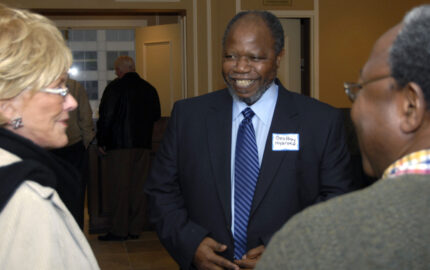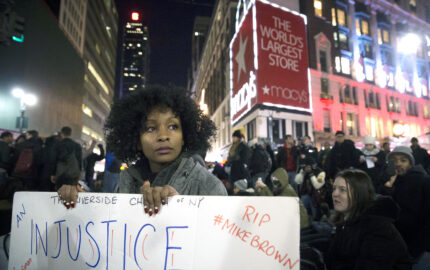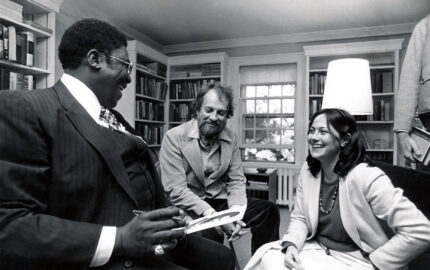Journalists learn a lot on the job, but one thing they don't learn is good journalism history. In newsrooms, reporters tend to absorb a local house history, a slapdash script full of legends that instruct and inspire and might even be true. But it's a narrow, parochial history.
When I worked at the Providence Journal-Bulletin in the 1970's and '80's, I heard folk tales about the noble crankiness of our city editor, Al Johnson, going back four decades. I was intrigued that two of the most skeptical critics of American journalism, A.J. Liebling and Ben Bagdikian, began at the Providence papers. (The Providence Journal, to its credit, produced an impressive official history on its 150th anniversary in 1980.) Later, at The Atlanta Journal-Constitution, I could trace that newspaper's house history by way of a miniature brass cannon in the lobby. Editors Henry Grady and Ralph McGill each fired that cannon in turn when the Democratic Party retook the White House, first in 1884, then in 1960. Their successor on the editorial page, Cynthia Tucker, aware of the racist background of the era that forged the cannon, declined to keep the tradition in 1992. When Bill Kovach was editor there in the 1980's, he restored and used the roll-top desk that had been Grady's and McGill's. Such is journalism history in the field.
I'm in academia now, where journalism history is more fussy and monkish, resting on agate footnotes and bibliographies. Not many journalism programs require media history for undergraduate majors. Here at Washington & Lee University, for instance, it was not even offered when I joined the department three years ago. We require ethics and law to round out the other requirements in reporting, writing, editing and production. There is little room for media history, since the bulk of a journalism student's education must be in other departments, to provide a strong liberal arts grounding. We would prefer that our students learn history in the history department. But if it could be squeezed in, journalism history could inspire and instruct future journalists in more sustaining ways than the parochial history they will pick up around the newsroom.
Learning the social history of news as a practice shines a whole new light on the so-called core values of the profession — objectivity, independence, fairness and all that. Historically viewed, these are not commandments divinely revealed, or platonic forms, but practices that emerge and change opportunistically over time. The study of media history shows a mass market not as inevitable, but an amazing evolution, infinitely rich and random. And the firewall between advertising and newsgathering is seen as the improbable miracle that it is. Or was. This understanding is the essence of a liberal-arts cast of mind, and it should be what we expect of an educated journalist.
Teaching history in a journalism department can have another side benefit, as I learned in designing a course I taught last fall called "Discovering Early American Newspapers." History, I have found, can be approached as a reporter would stalk a story, a search for revealing documents, tips, evidence and anecdotes. This is the way historians and their graduate students approach archival material. But it is generally not the way history is taught in college and high school, where students are force-marched through predigested facts and dates.
My university recently received a donation of more than 1,500 old newspapers, mostly 18th and 19th century American papers. The donor, Frederick Farrar, is a 1941 journalism graduate of Washington & Lee who became interested in teaching journalism history at the approach of the bicentennial in 1976. An ad executive at the time, he loved newspapers, old and new, and recognized the magic of using them to spark excitement about American history in high school classrooms. He earned a master's degree researching that idea and then for 10 years taught advertising and journalism history at Temple University. Farrar's collection of historic newspapers and periodicals grew ever larger as his shrewdness and luck at collecting became something amazing. He was elected to the American Antiquarian Society, the mother lode of old newspapers in Worcester, Massachusetts, founded by the father of journalism history, Isaiah Thomas, in 1812.
Farrar's collection itself was nothing to sneeze at. He had European papers as old as 1559 (a German-language account of the death of Henry II of France, not considered a newspaper by most historians because it was not a serialized publication), volumes of British periodicals from the age of Johnson, U.S. newspapers announcing elections of new Presidents from Washington to George W. Bush, and offbeat publications from periods of reform, war and depression. I wanted to put this donation to good use, so I secured a grant for one of my students to spend last summer getting bibliographic control over this material.1 Next, I designed a course around the Farrar Collection.2
I was tempted to use a good textbook as a road map for "Discovering Early American Newspapers." But I opted to keep as close as possible to the pure experience of encountering the hard data, the earth-crusted artifacts of what are called "primary sources." So our required text was David Copeland's "Debating the Issues in Colonial Newspapers: Primary Documents on Events of the Period," mostly selections from the newspapers themselves. Borrowing ideas from Farrar, I made students hold a press conference playing the role of an editor from history, many of whom were women who took over from their jailed brothers or dead husbands. And I made them pore over the actual papers, strange and beautiful messages with the long "s" ("Yr. humble Fervant") on gently washed rag paper. This is not just studying history. It's doing history. And in a way that I hope to continue to develop in future offerings of this course, it puts journalistic skills to work on news long dead, in hopes of bringing it back to life.
Doug Cumming, a 1987 Nieman Fellow, is an assistant professor of journalism at Washington & Lee University in Lexington, Virginia.
When I worked at the Providence Journal-Bulletin in the 1970's and '80's, I heard folk tales about the noble crankiness of our city editor, Al Johnson, going back four decades. I was intrigued that two of the most skeptical critics of American journalism, A.J. Liebling and Ben Bagdikian, began at the Providence papers. (The Providence Journal, to its credit, produced an impressive official history on its 150th anniversary in 1980.) Later, at The Atlanta Journal-Constitution, I could trace that newspaper's house history by way of a miniature brass cannon in the lobby. Editors Henry Grady and Ralph McGill each fired that cannon in turn when the Democratic Party retook the White House, first in 1884, then in 1960. Their successor on the editorial page, Cynthia Tucker, aware of the racist background of the era that forged the cannon, declined to keep the tradition in 1992. When Bill Kovach was editor there in the 1980's, he restored and used the roll-top desk that had been Grady's and McGill's. Such is journalism history in the field.
I'm in academia now, where journalism history is more fussy and monkish, resting on agate footnotes and bibliographies. Not many journalism programs require media history for undergraduate majors. Here at Washington & Lee University, for instance, it was not even offered when I joined the department three years ago. We require ethics and law to round out the other requirements in reporting, writing, editing and production. There is little room for media history, since the bulk of a journalism student's education must be in other departments, to provide a strong liberal arts grounding. We would prefer that our students learn history in the history department. But if it could be squeezed in, journalism history could inspire and instruct future journalists in more sustaining ways than the parochial history they will pick up around the newsroom.
Learning the social history of news as a practice shines a whole new light on the so-called core values of the profession — objectivity, independence, fairness and all that. Historically viewed, these are not commandments divinely revealed, or platonic forms, but practices that emerge and change opportunistically over time. The study of media history shows a mass market not as inevitable, but an amazing evolution, infinitely rich and random. And the firewall between advertising and newsgathering is seen as the improbable miracle that it is. Or was. This understanding is the essence of a liberal-arts cast of mind, and it should be what we expect of an educated journalist.
Teaching history in a journalism department can have another side benefit, as I learned in designing a course I taught last fall called "Discovering Early American Newspapers." History, I have found, can be approached as a reporter would stalk a story, a search for revealing documents, tips, evidence and anecdotes. This is the way historians and their graduate students approach archival material. But it is generally not the way history is taught in college and high school, where students are force-marched through predigested facts and dates.
My university recently received a donation of more than 1,500 old newspapers, mostly 18th and 19th century American papers. The donor, Frederick Farrar, is a 1941 journalism graduate of Washington & Lee who became interested in teaching journalism history at the approach of the bicentennial in 1976. An ad executive at the time, he loved newspapers, old and new, and recognized the magic of using them to spark excitement about American history in high school classrooms. He earned a master's degree researching that idea and then for 10 years taught advertising and journalism history at Temple University. Farrar's collection of historic newspapers and periodicals grew ever larger as his shrewdness and luck at collecting became something amazing. He was elected to the American Antiquarian Society, the mother lode of old newspapers in Worcester, Massachusetts, founded by the father of journalism history, Isaiah Thomas, in 1812.
Farrar's collection itself was nothing to sneeze at. He had European papers as old as 1559 (a German-language account of the death of Henry II of France, not considered a newspaper by most historians because it was not a serialized publication), volumes of British periodicals from the age of Johnson, U.S. newspapers announcing elections of new Presidents from Washington to George W. Bush, and offbeat publications from periods of reform, war and depression. I wanted to put this donation to good use, so I secured a grant for one of my students to spend last summer getting bibliographic control over this material.1 Next, I designed a course around the Farrar Collection.2
I was tempted to use a good textbook as a road map for "Discovering Early American Newspapers." But I opted to keep as close as possible to the pure experience of encountering the hard data, the earth-crusted artifacts of what are called "primary sources." So our required text was David Copeland's "Debating the Issues in Colonial Newspapers: Primary Documents on Events of the Period," mostly selections from the newspapers themselves. Borrowing ideas from Farrar, I made students hold a press conference playing the role of an editor from history, many of whom were women who took over from their jailed brothers or dead husbands. And I made them pore over the actual papers, strange and beautiful messages with the long "s" ("Yr. humble Fervant") on gently washed rag paper. This is not just studying history. It's doing history. And in a way that I hope to continue to develop in future offerings of this course, it puts journalistic skills to work on news long dead, in hopes of bringing it back to life.
Doug Cumming, a 1987 Nieman Fellow, is an assistant professor of journalism at Washington & Lee University in Lexington, Virginia.



